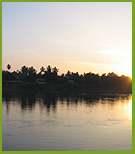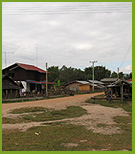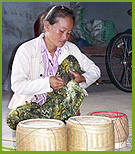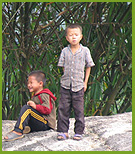Trekking at Ban Hatkhai
A Brief Introduction and Trail Map for Tourists
Ban Hatkhai - a village with charm
 |
Ban Hatkhai, a small village at the edge of Phou Khao Khouay National Protected Area, is an ideal starting point for staggering trekking tours into the mountainous area along the ‘Nam Mang’ river. This more than 200 years old village in the Province of Bolikhamsay (Thaphabath District) is home to two ethnic groups commonly but incorrectly called “Lao Lum” and “Lao Soung” (about 30%). About 90 families with nearly 600 people are living here. Their forefathers and village founders originated from Houaohanh province. Today, most of them are subsistence farmers (predominantly rice and vegetable). Non-timber forest products or “NTFP” are collected in the nearby forest to supplement the daily staple. Several of the young women left the village for working in distant towns and villages or as far as Vientiane.
By entering the village, one can see already the mountains of Phou Khao Khouay ahead in the mist, the destination for several exciting trips possible from Ban hatkhai. Following the road straight ahead to its dead end seven kilometer away, the most beautiful waterfall of this mountain range, Tad Xay, could make your day. A small community forest on the left side of the road remains untouched because villagers, who passed away are laid to rest here and their spirits are given a new home.
Ban Hatkhai certainly will charm away its visitors with its huge picturesque fig trees at the banks of the Nam Mang River and the rice fields expanding right into the village. Listen to the bells of the water buffaloes, reminiscent of a pasture in the Swiss Alps... Enjoy a breakfast under the shade spending trees at the river after spending a night in one of the older village houses or sip a cool drink here while relaxing after an exhausting trek. Experience the hospitality of the villagers who are always happy to give you an edge.
Some useful information
the treks from Ban Hatkhai can be clearly distinguished regarding their level of difficulty for the inexperienced visitor. See also next chapter. It’s nothing hard core, though.
All visitors should bring along good spirits and an open mind. Bring enough water for drinking water - and, if needed, for refreshment. During the dry season it may be hot on the plateau, with no water in sight - or only the Mekong at the horizon... For sure, there will be no refreshment store on the way and you’ll definitely lose several liters of water during a trek, even it’s a simple one.
Home-stay accommodation is available in the village. Though the villagers can provide some basic food for the tour for a small extra fee and on request, extraordinarily hungry people should bring along some additional food, if they wish so. Porters can also be hired in the village...
 |
Unfortunately, our guides do not speak English. Not yet. Sorry, but we’re working on that! Language lessons are offered occasionally by volunteers, but it’s an illusion that the guides will be able to explain complicated matters within a relatively short period of time. But they are prepared to give you some printed information about the most important forest plants used in the village and wildlife for your briefing - without, of course, carrying too many books around. Take it as an experience and challenge to be in a new country and dealing with the locals. If you nevertheless prefer to have an English-speaking guide ‘on board’, please ask your tour operator.
Please observe and understand local customs: It may happen that guest have to sleep in different houses, separated by their sex, since visiting men and women are not allowed to sleep under one roof, even married couples. So, be prepared (just in case) to get separated for the night in the village....
Visitors are urgently advised not to hand out candies or, even worse, money to children. This will only encourage them to develop a begging habit in the future - which should be avoided by all means. If you want to help just give some money or other useful items such as pens to the school.
Destinations for trekking at Ban Hatkhai (guided tours only!)
As an “easy tour” from Ban Hatkhai, a trip to Tad Xay and Pha Xay waterfalls is highly recommended. Like all tours from this village, the excursion starts with a 45-minute boat trip. The trek itself is not difficult and takes a bit more than an hour for an average conditioned traveler. Tad Xay is said to be the most attractive waterfall in the park. A large water pool invites all year around for a refreshing swim (don’t forget to bring suitable clothes). But it is not easy to get into the water. It’s a bit rocky there. So, take special caution.
Just a few hundred meters downstream of Tad Xay you can explore also Pha Xay, the beautiful 50-meter cliff. In the dry season you can walk in the river bed, while during the rainy season the Houay Xay turns into torrential stream, impossible to cross. The white waters then plunge down with deafening thunder. The guides will definitely bring you to both sites. Beautiful orchids you’ll find everywhere.
Longer treks to various places are rewarding, too, such as one to the top of the Pha Luang cliff, an estimated 100-meter high almost vertical rock wall. On top is a large sandstone plateau with its very own flora. Here you have a stunning view on the Nam Mang river deep down and the Mekong lowland in some distance with neighboring Thailand (Isan) on the other side. Spend your day here to explore the beautiful nature and the different excellent views in the area. But be extremely careful not to come too close to the edge of the cliff! There’s no fence and no one can pick you up... After few hours you may return the same way to Ban Hatkhai .You need a full day for this a bit exhausting trip and you should be fit for long walks in sometimes steep terrain. Going up the mountain needs about three hours from the boat landing place. The boat trip needs another 45 minutes one way.
On a round-trip to/from Pha Luang, you may proceed to Houay Ki Ling,a nice small creek surrounded by beautiful forest. An over-night stay in lush nature at its finest could be suggested here. Return to Ban Hatkhai the next day. A one-day trip to this place from the village and back is, of course, also possible. Also this destination is combined with a boat trip of 45 minutes one way.
A combination of all trips offers different options and you may tailor your tour according to your own plan. Please let the tour guides know and try to discuss potential alternatives and time constraints. Even multiple-day treks from Ban Hatkhai to Long Xan can be organized! Such a trip is only possible with prior notice to the village for preparation, and your willingness to sleep on the forest ground, unless you have own camping equipment.
You may also pay a visit to the nearby Tad Leuk, but without own transpotation is may prove to be quite difficult. To walk there from Ban Hatkhai is not recommended (except along the dusty road - about 15km).
Community Development - Or where your money goes...
Tourism at Ban Hatkhai started with realizing that many day-trippers, mostly from Vientiane, passed the village with their speeding big cars heading for Tad Xay, leaving nothing in the village but a could of reddish-yellowish dust... “Fortunately”(?), the bridge before the village is broken and the number of cars has been reduced naturally - for the time being.
 |
Most of the villagers of Ban Hatkhai are subsistence farmers (rice, vegetables and others). Many of the women go day by day into the forest to collect food supplements or herbal medicines. Men, in turn, may go for hunting, not seldom illegally straying into the nearby Protected Area, or for fishing in the numerous creeks during the rainy season. The search for such non-timber forest products or “NTFP” is an old traditional practice, but has taken on such dimensions that their removal turned to be unsustainable. It has to be stressed here, though, that this is a general problem (statement) and not a specific one for Ban Hatkhai! The sustainable collection of NTFP is not discouraged.
The Ban Hatkhai Tourism Development Project aims to address this issue by having the villagers participate in the development of the park - and winning their hearts for the idea of nature conservation. From the beginning, the villagers were very open to this idea. “ Falangs ” ( foreigners ) flocking into their village is a new experience of Ban Hatkhai. In numerous introductory village meetings and with extensive training, interested villagers have been prepared for the reception of visitors wanting to see their beautiful village lands or “their” protected area nearby.
Benefits for the people, to be realistic, must be reflected in financial gains, through jobs and small business development. It must be ensured that no false hopes are built up in the village, otherwise the sustainability of the project will be at stake quickly. It is also crucial to maintain the village’s social structure and to avoid creating any new dependencies by focusing solely on tourism, an industry vulnerable to diverse imponderables, nationally as intermationally.
Please keep in mind that with your booking of a trip to Ban Hatkhai you’re directly contributing to the development of a rural community and conservation of nature. Main beneficiaries are the enthusiastic guides (who all come directly from Ban Hatkhai ) who get their share for their responsible job. Others are selling food and drinks, offer their homes for accommadation, or renting out their boats.
 |
A considerable part of your contribution is flowing into so-called ‘Revolving Fund’, a village-owned banking system, from which all villagers are entitled to borrow money for their own farm projects, for schooling fees of their children, in case of emergency or any other personal financial problem. Of course, the money must be paid back within reasonable time, thus money never should get lost. A trained village committee manages the funds, and loans are agreed upon and handed out in public meetings only.
The local District authorities and the Phou Khao Khouay park management jointly issue ‘trekking permits’ for each tourist. The revenue, though small, shall be used for conservation activities and tourism infrastructure development.
The whole affair is new for the villagers and even for the local authorities. Therefore, please keep in mind that not everything is near to perfect as we wished it to be. Visitors are asked to understand the difficulties the villagers still have to please their quests. It is safe to say that they are doing their best! With more time and more experience any such problem with disappear. Ban Hatkhai now gives the opportunity to experience a friendly and authentic Lao village managing its own community-based tourism business, not spoiled by commerce.
Some words about the expenses
The costs for the services of Ban Hatkhai are split up as follows (a minimum of 2 travelers is required):
- 70,000 kip per guide and day (exchange rate : us 1 = 8,500 kip),
- 50,000 kip per person and visit (not per day) as contribution for the ‘Village Revolving fund’,
- 40,000 kip per person and visit (as above) for issuing a ‘Trekking Permit’ (75% for the park, 25% for the district),
- 70,000 kip per boat and day (max. 4-5 passengers per boat; essential, since all trips start with a boat ride!),
- 20,000 kip for a meal for person
These given prices are due in the village and do not include transportation and other possibly requested logistics from Vientiane to Ban Hatkhai – they may be relatively costly if one does not take the “adventurous risk” of travelling by oneself. Please contact your tour operator. All prices stated here are valid during the date of writing and until further official notice.
Website and leaflets for further information
Visit our website and get more information about community-base tourism in Ban Hatkhai and other destination in and around Phou Khao Khouay National Protected Area: www.trekkingcentrallaos.com. Have a look also in www.ecotourismlaos.com.
Special information leaflets for Tad Xay / Pha Xay and also for Tad Leuk with site trail maps are available! Ask your tour operator or in the LNTA Tourist Information Canter in Vientiane for a copy.
How to get here?
Any tour operator in Vientiane may arrange a trip to Ban Hatkhai. Ideally, groups of six to seven people are preferred but not compulsory, though the formation of bigger groups is discouraged. Tour companies may also provide an additional guide for interpretation. Please inform the villagers ahead of your arrival (Tel: 020 224 03 03) Mr. Khammoune.
Ban Hatkhai is located quite exactly 100 km or about 11/2 hours drive from Vientiane, following National Highway No. 13 south up to Thabok. There you have to turn left (large signboards at “km 90” will guide you). The dirty but all-season road will pass Ban Houay Leuk (after 5 km; then follow the wooden signs “National Park”). Less than a kilometer after crossing an iron bridge (Num Leuk river) you turn right (sign “Tad Xay”). After another kilometer you’ll be stopped by a broken bridge. The makeshift bridge can be tricky. Not everybody dares to use it. Repairs (when?) are planned but proved to be extremely costly – if not completely unaffordable – for the villagers. It is therefore recommended to park your car near the bridge and walk the last half kilometer or so to the village. If you notify the guides before your arrival, they may also pick you up at Ban Houay Leuk by boat from the iron bridge.
Ban Hatkhai can be reached by public transport, too. Busses heading to the south and “bush Taxis” (“songtaew”) are starting either at the bus station near the Talat Sao (Morning Market) or at the Talat Tad Luang market. Here even one “bush Taxis” directly from (and to) Ban Hatkhai might be found “sometimes in the morning”. Jump off the bus at the junction in Thabok (Ban Palai) or at the market and fetch one of the “bush Taxis” heading for Long Xan valley (in the north of the park). Tell the driver you’re planning to go to Ban Hatkhai and ask to drop you at the junction to Tad Xay (less than 2km from here to the village, but you have to walk). |

